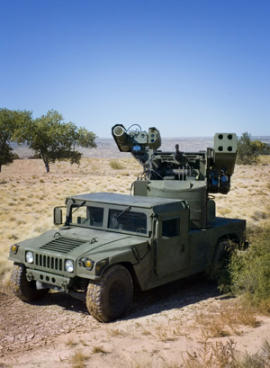 There’s still a lot of blue sky in Boeing’s plans for directed-energy weapons like the Laser Avenger. (Credit: Boeing) |
Updated 2:40 p.m. with details on how the laser damaged the UAV and on the Laser Avenger’s targeting system.
Boeing is seeing a glimmer of progress in its work toward fielding laser weapons.
The defense industry giant on Monday said tests of its Laser Avenger system in December marked “the first time a combat vehicle has used a laser to shoot down a UAV,” or unmanned aerial vehicle. In the testing, the Humvee-mounted Laser Avenger located and tracked three small UAVs in flight over the White Sands Missile Range in New Mexico and knocked one of the drone aircraft out of the sky.
Boeing didn’t go into much detail about the shoot-down. In response to a query by CNET News, it did say this much about the strike by the the kilowatt-class laser: “A hole was burned in a critical flight control element of the UAV, rendering the aircraft unflyable.”
While decades of Hollywood imagery may conjure up a vision of a target disintegrating in a sparkle of light, the actual workings of the laser beam are probably more prosaic. For instance, the beam from Boeing’s much, much larger Airborne Laser, which is intended to disable long-range missiles in flight, uses heat to create a weak spot on the skin of the missile, causing it to rupture in flight. Boeing hopes to conduct the first aerial shoot-down test with the much-delayed 747-based Airborne Laser later this year.
In tests in 2007, the Laser Avenger “neutralized” improvised explosive devices (IEDs) like those that have been a deadly threat in Iraq, along with other unexploded munitions.
Those types of targets don’t move, so the ability to track and zap a small aircraft in flight is clearly a step forward for directed-energy weapons. But testing on a missile range is still a far cry from effective use on the battlefield, where military units may have to fire on the move against multiple targets approaching through cluttered airspace.
It’s not clear how long the laser beam has to be locked on a target such as a UAV before it can cause sufficient damage, or how well the beam can be corrected to deal with dust and other atmospheric disturbances.
Here’s how the targeting system works, according to the company (FLIR stands for “forward-looking infrared”):
The laser system is completely integrated to the Avenger turret and works independently of on-board wide field of view camera/FLIR systems. The laser system can work together with on-board wide field of view camera/FLIR systems and slew-to-cue fire control system of the Avenger turret.Once a target has been sighted, the laser system will “zoom in” on the target and use advanced UAV tracking algorithms to acquire and track the target even in heavy background clutter. Only after positive identification will it fire the high energy laser.
Boeing is pitching the Laser Avenger–and these are Boeing’s own words–as a defense against UAVs “like those that increasingly threaten U.S. troops deployed in war zones.” In the near term, of course, it’s exactly the opposite–UAVs such as the Predator from General Atomics and Boeing’s ScanEagle are a boon to U.S. troops and represent a distinct tactical advantage for U.S. forces against al-Qaeda and other foes. The MQ-1 Predator, in particular, has been very successful as both a reconnaissance tool and a weapons platform.
The Boeing-funded Laser Avenger is based on the existing Avenger platform, which carries more traditional “kinetic” weapons, including Stinger antiaircraft missiles and a .50-caliber machine gun.
January 26, 2009 12:13 PM PST
Source: CNET News